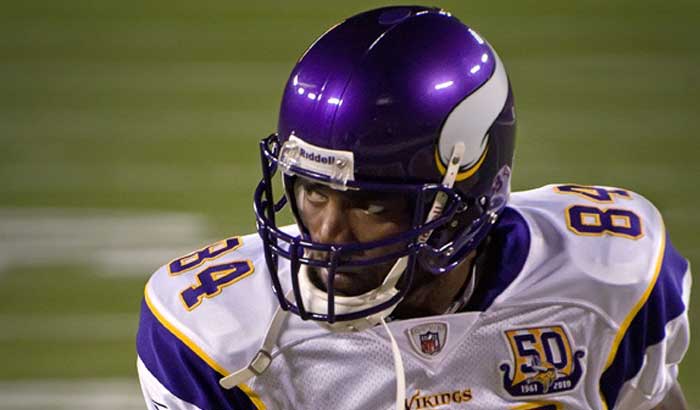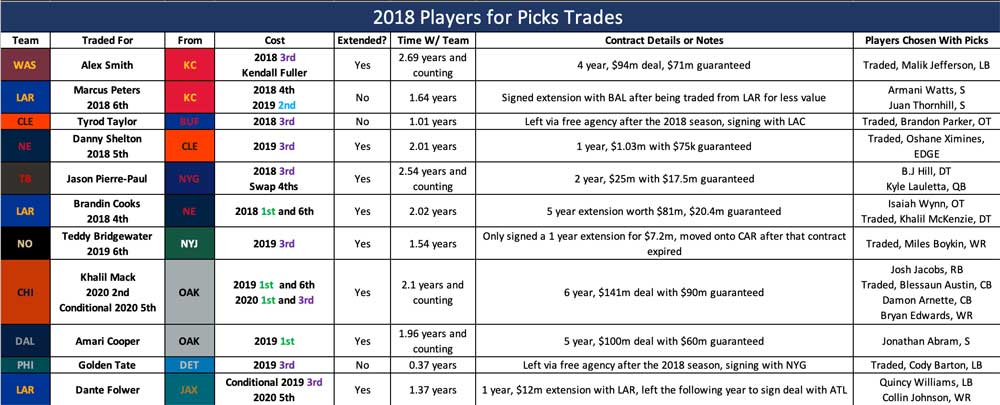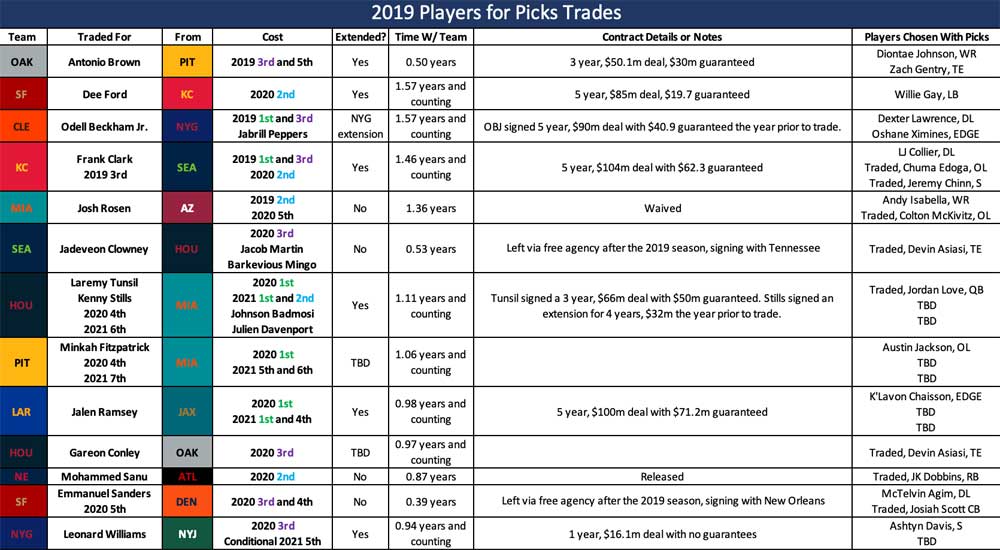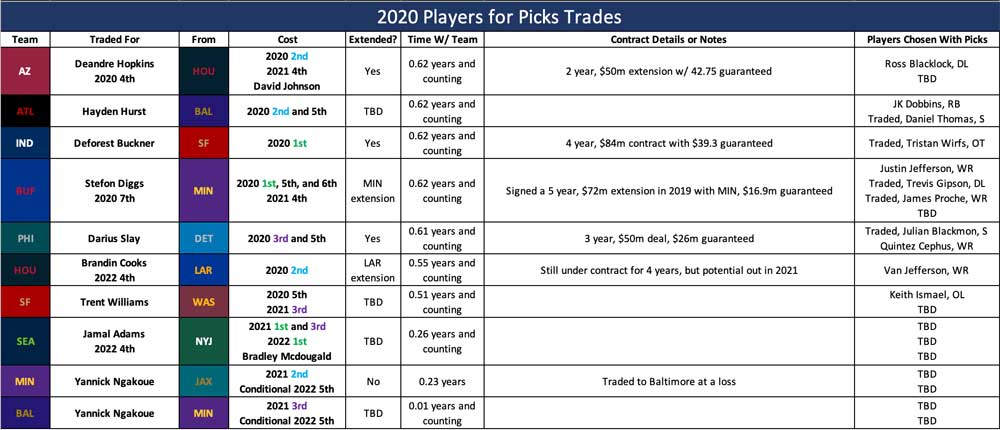Analysis
10/26/20
6 min min read
Deep Dive: Assessing Value When Trading NFL Draft Picks for Veteran Players


DeAndre Hopkins, DeForest Buckner and Yannick Ngakoue. All three are established Pro Bowl players whose teams felt there was more value in trading them than keeping them on the roster (in Ngakoue’s case, twice). These types of deals are happening more frequently over the last two years. As front-office execs are looking to established veterans as opposed to taking their chances in the draft.
If that’s the case, why haven't these trades been more prevalent for years? Drafting a consistent starter is considered hit-or-miss in most circumstances, so why take a chance on drafting a player who can't play in the NFL when you can trade a pick for someone who has already proven to have NFL ability?
To gain a better understanding of why NFL teams have been so hesitant to trade for established starters and to get a grasp of what general managers are using to establish trade values for veterans, an understanding of recent trends is required. For this study to focus on trades for players that are of starting quality, the trades were limited to players who were traded for at least a first- second- or third-round pick. Some players and later picks were included in larger trades, but the minimum requirement for a trade to be considered was a third-rounder. Looking at transactions since 2010, there are some obvious examples of what scares GMs out of these blockbuster trades.

The first details that should stand out are some of the marquee names that were dealt in 2010. Donovan McNabb and Randy Moss were legendary in their stints with the teams who traded them, but the organizations felt it was time to move on from these veterans. Anquan Boldin and Brandon Marshall will be reappearing in later seasons, so keep an eye out for them.
Arguably the most important detail that will become a trend in this study is the time spent with the team that traded for the player. Moss is one of the more egregious examples of this over the past decade, but the time spent with the team is an important detail to focus on. How much value did the Vikings lose in giving up a third-round pick for a franchise legend?

To understand that lost value -- we’ll call it “time value” -- of players, compare Moss’ time with the Vikings to the average longevity of players with their drafted teams from 2010-2013. While these players are unproven and provide no guarantees in quality of play, the Vikings lost over three years of time value from their third-rounder that was dealt to New England.
Teams seemed to get burned over the next few years in deals for players who signed huge new contracts, leading to a downturn in trade activity from 2011 to 2014.




Obviously who wins and who loses a trade is mostly circumstantial and opinion-based, but there are multiple ways that you can look at the results of these transactions. The value given up for the player is the most obvious, but what teams do with these picks is also interesting. In essence, the Seahawks traded got 1.6 years of Percy Harvin in exchange for Xavier Rhodes, Travis Bond and Jerick McKinnon, two of whom proved to be major contributors in the NFL.
By calculating the time value of the picks in the previously mentioned Seattle-Minnesota deal for Harvin, Seattle gave up 8.87 years of 2013 time value in just their first and third picks for what was basically a rental player in Harvin.
With a hit rate of basically one player per year, the NFL took notice and saw that keeping their picks was becoming more valuable than trying to patch rosters with veterans. Outside of the incredible success found by Greg Olsen in Carolina and some productive years from Alex Smith and Vontae Davis with their second teams, many of these trades proved to be major losses for front offices that were expecting plug-and-play starters.


After a one-year break from major trades, a few teams came together to jumpstart the market with some successful deals in 2015 and 2016. Kenny Stills proved to have value for Miami and Chandler Jones -- arguably the best value provided in this entire study -- has proven to be worth every ounce of value that Arizona gave up for him. Despite the deal for Jones being the biggest steal over these two seasons, every transaction proved to be useful for the teams trading for veterans, as all of these players made fairly large impacts with their new teams.

The 2017 season is where the recent growth in the veteran trade market truly begins, where impactful starters are being dealt around the league. The results were a mixed bag, as players like Kony Ealy and Sammy Watkins had short stints with their new teams while Jimmy Garoppolo and Duane Brown are entrenched as key pieces with their new offenses. Watkins and Richardson were essentially rental players for teams who felt they needed the help on a playoff push, but were unable to reach long-term deals with these teams and eventually hit free agency. These types of trades prove to be a huge risk for teams, as they are only valuable in the long run if the player is a contributor to a Super Bowl run, which did not happen for either of these players.

Taking all factors into consideration, 2018 seems to be the most successful year of trades in recent memory. Even most of the players who are no longer with the teams that traded for them were contributors in some form or fashion; Teddy Bridgewater filled in nicely for an injured Drew Brees and Tyrod Taylor was an excellent transitional quarterback to ease Baker Mayfield into the starting role in Cleveland.
One of the most interesting things to focus on from 2018 is the alleged “fire sale” that Oakland had when Jon Gruden took over. Trading Amari Cooper and Khalil Mack upon his arrival was highly scrutinized in the moment, but turned out to be just as successful for them as it was for the teams they traded with. The now Las Vegas Raiders have drafted some very talented contributors with the draft capital collected in these trades, including one of the best running backs in the league in Josh Jacobs.


After having looked at all the trades since 2010, it’s time to take a look at the most recent transactions. Since they are both still fairly current and most of the players are still with their teams, we’ll combine 2019 and 2020 in analysis. After getting great value for trading away assets in the previous year, the Raiders essentially wasted two picks in the Antonio Brown debacle to kick off the new league year. Other teams shared similar struggles with trades, such as Miami acquiring Josh Rosen and New England trading for Mohamed Sanu.
While the trade market was particularly lucrative for teams in need of pass rushers, it was no guarantee that the players stayed with these teams. Dee Ford and Frank Clark inked enormous deals with their new teams, but Seattle was unable to retain Jadeveon Clowney after a rental season and Yannick Ngakoue recently became the first player to be involved in back-to-back trades within our constraints. Brandin Cooks was another frequent guest on the trading block, making three appearances since the beginning of the 2017 league year. What is most interesting about Cooks being traded so frequently is that he always fetched a premium price tag despite the unwillingness of teams to keep him on their rosters.
In the end, only 25% of players who were traded for premium picks from 2010-2016 were kept on rosters for more than four years, which is about the average for premium draft picks during that time. Six of eight players (75%) who were traded for premium picks have already been moved off the roster, also failing to meet that threshold. While the league hopes for more longevity from veteran players in the future, it’s unrealistic to expect much variation from the 25% success rate going forward.
So what could be causing such a low rate of perceived success? Many of these players came with a history of trouble and were unable to change their ways with new teams. Some were draft busts looking for a fresh start, and some were simply not a culture fit for their new teams. It turns out that the theory of simply patching roster holes in free agency isn't as predictable as some fans would expect. The truly great organizations in the NFL have built their teams through strong scouting, both collegiate scouting and professional. Without that strong foundation provided by a well-educated personnel department, teams are much more likely to fall into that 75% failure rate for these blockbuster trades.
Long story short, building a Super Bowl champion is much more difficult to do in real life than it is in Madden.








